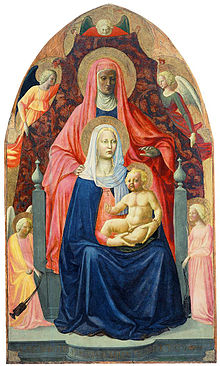|
Masolino da Panicale
Tommaso di Cristoforo Fini (c. 1383 – c. 1447), known by his nickname Masolino da Panicale (lit. 'Tommy from Panicale'), was an Italian painter. His best known works are probably his collaborations with Masaccio: Madonna with Child and St. Anne (1424) and the frescoes in the Brancacci Chapel (1424–1428). BiographyMasolino was possibly born in Panicale, present-day Umbria.[1] He may have been an assistant to Ghiberti in Florence between 1403 and 1407.[2] In 1423, he joined the Florentine guild Arte dei Medici e Speziali (Doctors and Apothecaries), which included painters as an independent branch. He may have been the first artist to create oil paintings in the 1420s, rather than Jan van Eyck in the 1430s, as was previously supposed.[3] He spent many years traveling, including a trip to Hungary from September 1425 to July 1427 under the patronage of Pipo of Ozora, a mercenary captain. He was selected by Pope Martin V (Oddone Colonna) on the return of the papacy to Rome in 1420 to paint the altarpiece for his family chapel in the Basilica of Santa Maria Maggiore, and later by Cardinal Branda da Castiglione to paint the Saint Catherine Chapel in the Basilica of San Clemente, Rome. In the interim, he collaborated with his younger colleague, Masaccio, to paint the frescoes in the Brancacci Chapel in the Basilica of Santa Maria del Carmine, Florence, which were much admired by fellow artists throughout the fifteenth century. He painted a cycle of 300 famous historical figures in the Orsini Palace in Rome about 1433–34[4] and also worked in Todi. He spent his later years, after 1435, working for Cardinal Branda Castiglione in Castiglione Olona.[5] Early use of the central vanishing pointMasolino was probably the first painter to make use of a central vanishing point in his 1423 painting St. Peter Healing a Cripple and the Raising of Tabitha.[6] St Catherine Refusing to Worship Idols"The lunette of the left-hand wall, depicting St Catherine Refusing to Worship Idols. In an elaborate temple setting, Catherine is pointing toward heaven, while the emperor, here bareheaded, gazes up at the idolatrous statue atop the altar. His retainers are crowded behind them, one of them, only partially visible, is sounding a trumpet."[7] Summary of work
   Complete works
In Germany:
In Florence:
In Empoli:
In Rome:
In Castiglione Olona, where his patron was cardinal Branda da Castiglione:
In France:
In the United States:
Dispersed pieces of works
References
External linksWikimedia Commons has media related to Masolino.
|
||||||||||||||||||||
Portal di Ensiklopedia Dunia
